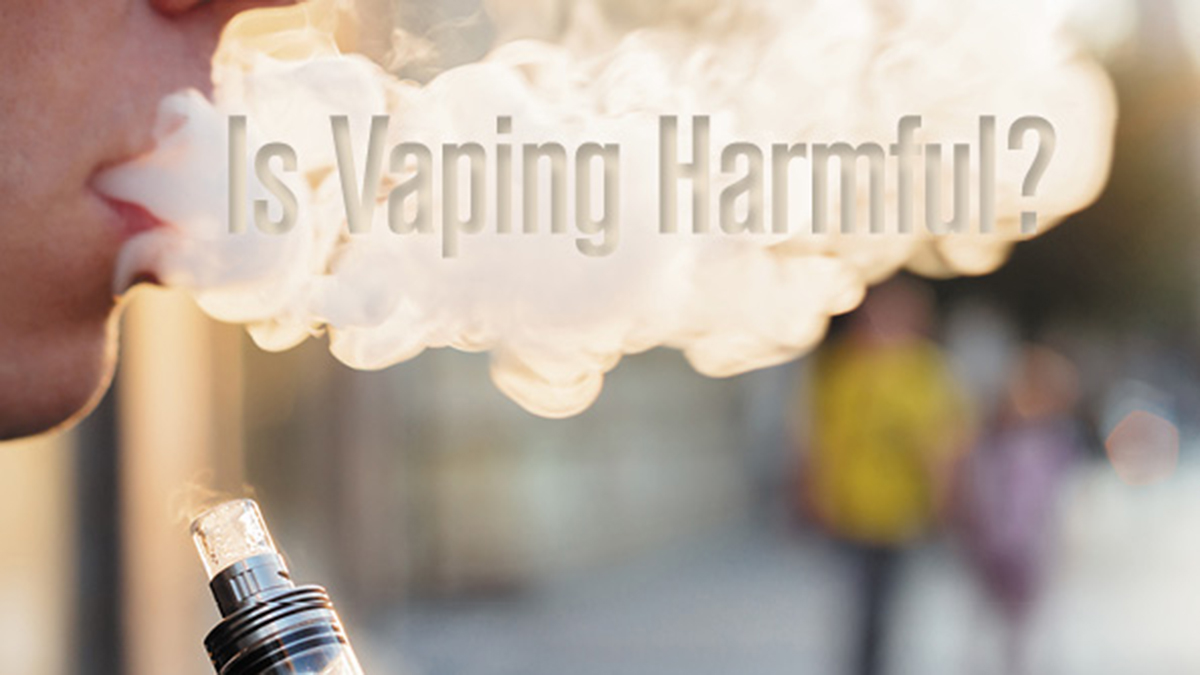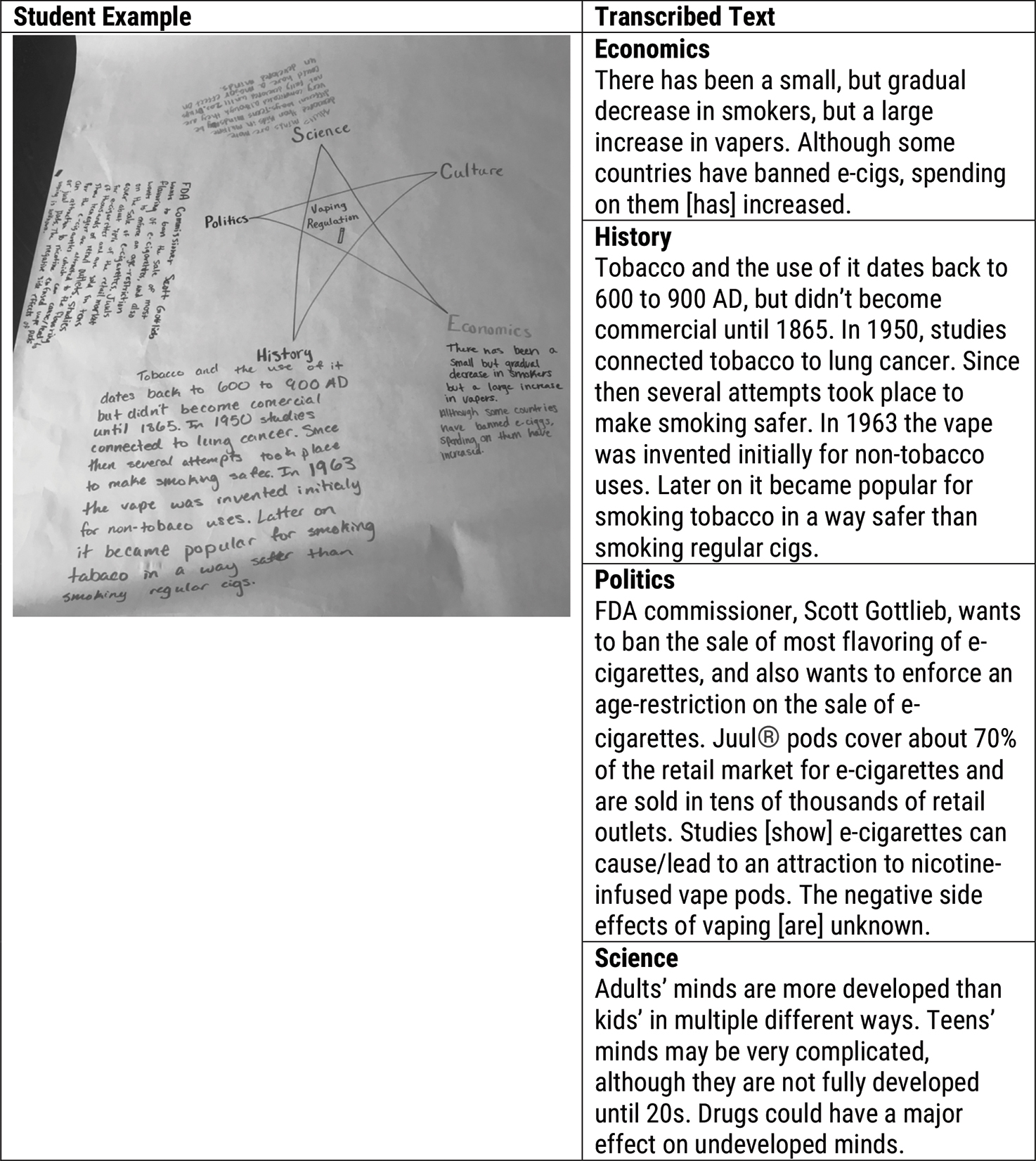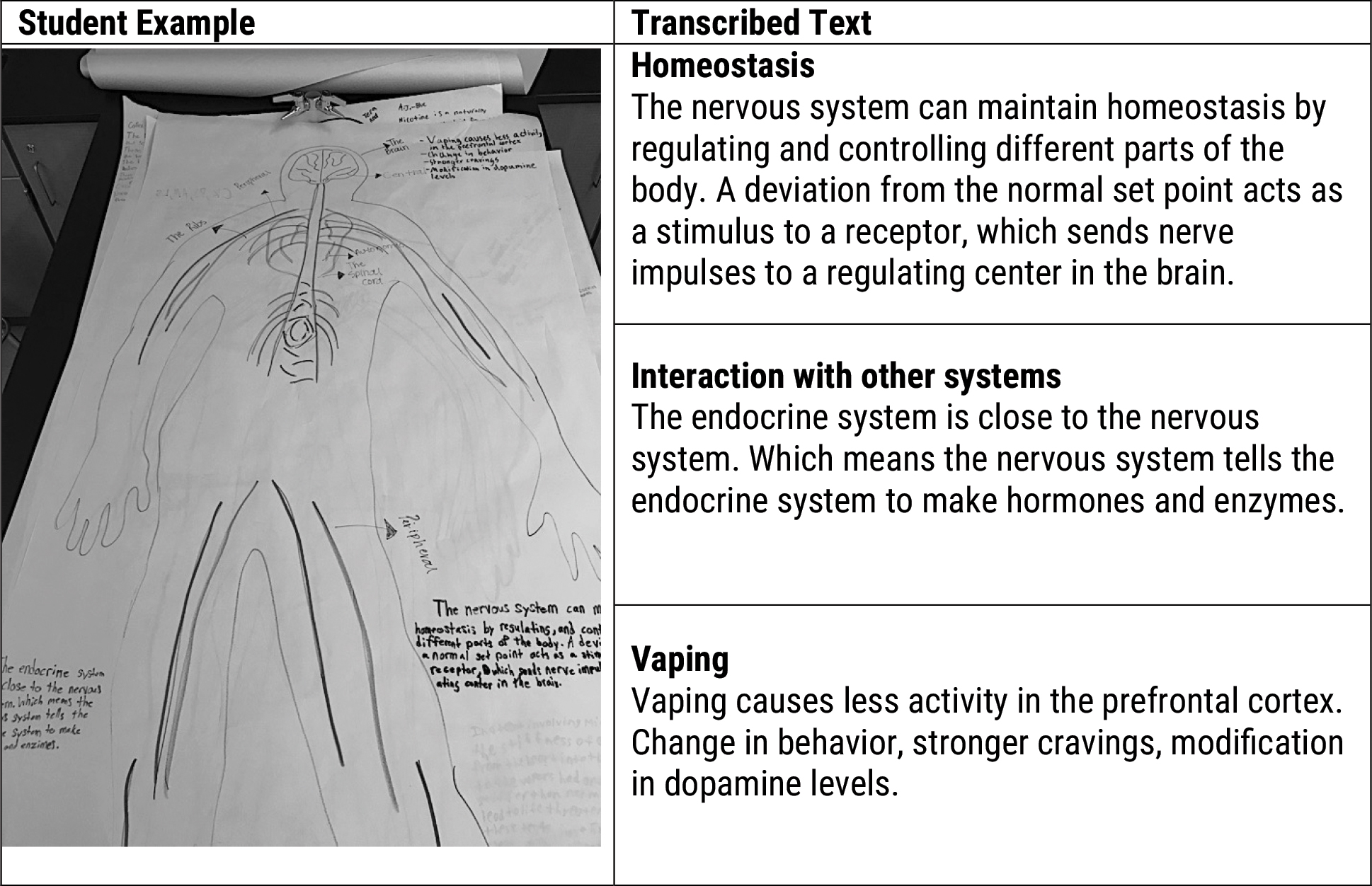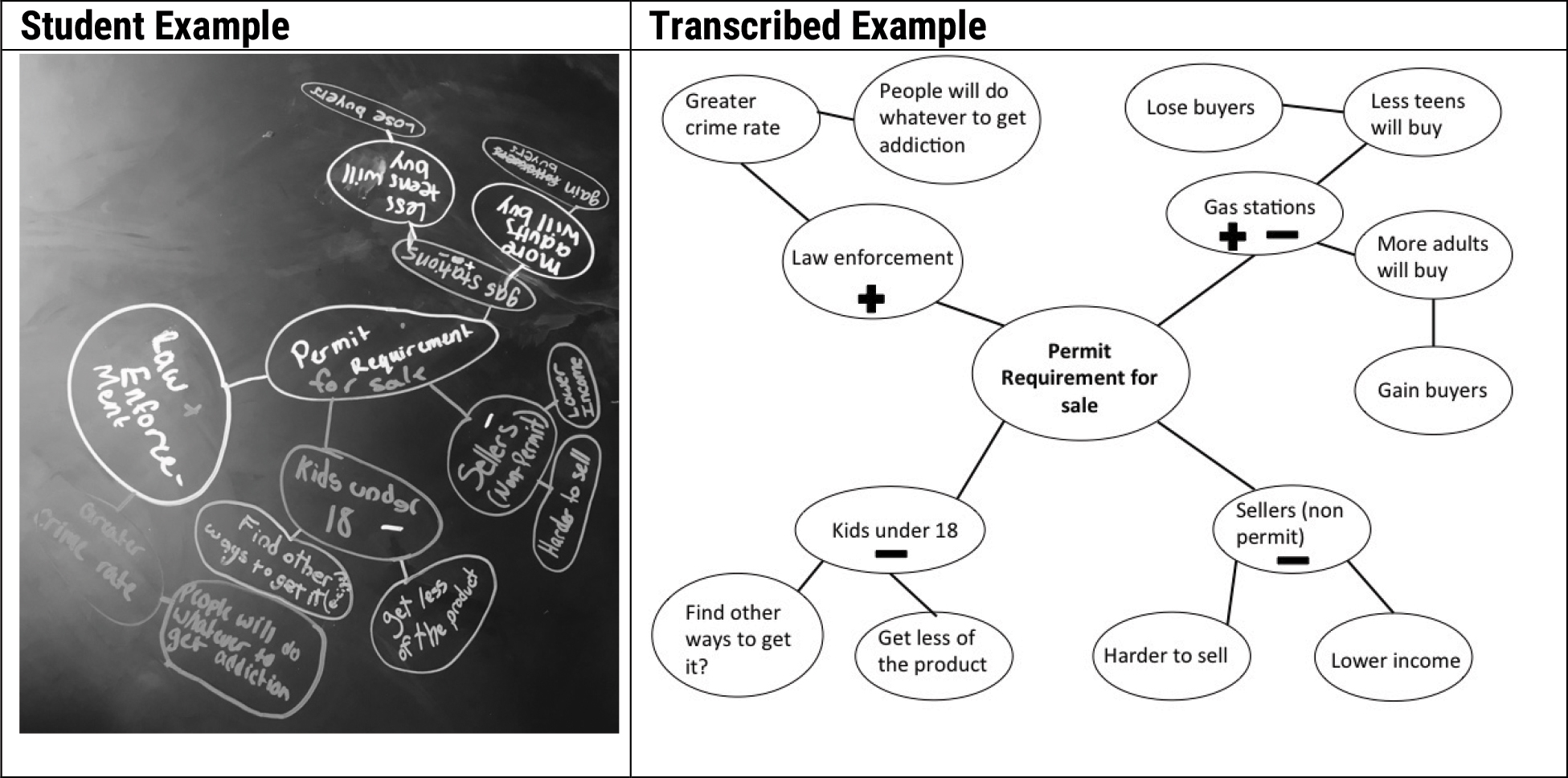feature
Is Vaping Harmful?
Using the issue of e-cigarette regulation to teach homeostasis and feedback loops
The Science Teacher—September/October 2020 (Volume 88, Issue 1)
By Amanda Peel, Jordan Rockett, Patricia Friedrichsen, Laura Zangori, Clayton Elmy, and Brandon Wagner

Socio-scientific issues (SSI) are real-world issues with clear ties to science ideas and societal concerns, such climate change, resource management, and antibiotic resistance (Sadler, 2004). Using an SSI approach to teaching science can result in increased student learning in science content, nature of science ideas, and understanding of science practices (Eastwood, Sadler, Zeidler, Lewis, and Applebaum, 2012; Klosterman and Sadler, 2010; Zangori, Peel, Kinslow, Friedrichsen, and Sadler, 2017). This article describes a high school biology unit which uses the issue of e-cigarette regulation to teach homeostasis, feedback loops, body system hierarchy, and macromolecules.
Vaping (the use of an e-cigarette) is a common practice among teenagers; 26.7% of high school students report vaping in the last 30 days (Johnston, Miech, O’Malley, Bachman, Schulenberg, and Patrick 2019), making this issue highly relevant. In order to make an informed decision about the use of e-cigarettes, students need to understand the impacts of vaping on their body, which makes the science content engaging and meaningful. We describe the Vaping Unit by giving an overview of the unit lessons and timeline, a description of key lessons with student examples, and results of a student survey. The entire unit is available at ri2.missouri.edu.
Vaping unit
The focal SSI question is: “How should vaping be regulated?” In order to have informed positions on this issue, students need to learn science content as well as explore social aspects of the issue. As such, vaping and how it disrupts homeostasis is the anchor phenomenon explored in this unit. The unit includes several key features of SSI teaching:
- engaging in model-based reasoning
- supporting students in developing their own positions
- investigating multiple perspectives
- exploring the complexities of an issue (Zangori, Foulk, Sadler, & Peel, 2018).
To help students understand vaping and its impact on the body, we focus on nicotine as a disruptor of homeostasis, resulting in lessons about nicotine’s impact on body systems and cellular function. We explore homeostasis with positive and negative feedback loops, cell transport and diffusion through membranes, and body system function and interaction. Students use the scientific practice of modeling to make sense of the science content associated with the vaping anchor phenomenon.
Unit outline
The unit consists of 10 lessons ranging from 90 minutes to 180 minutes, as described in Table 1. We explore the complexities of the vaping regulation issue through developing science content knowledge and exploring social aspects of the issue through political, cultural, economic, and historical lenses. As students learn the science content, they draw, evaluate, and revise models of their own design to explain vaping’s impact on the body. At the end of the unit, students use the social and scientific information gathered during the lessons to take a position on e-cigarette regulation, map its impacts, and create a final product explaining their position and the science of vaping. Key lessons in developing reasoning about the issue and content are described below with student examples. Please visit http://ri2.missouri.edu/ri2modules/Vaping/intro for the full unit and lesson plans.
| Table 1. Lesson sequence and timing. | |||||||||||||||||||||||||||||||||
|---|---|---|---|---|---|---|---|---|---|---|---|---|---|---|---|---|---|---|---|---|---|---|---|---|---|---|---|---|---|---|---|---|---|
|
Introduction to vaping unit
We introduce the unit by showing online videos representing a variety of perspectives on vaping, including how vaping harms people, the perceived benefits of vaping, and vaping competitions. We do not approach the unit with the message that vaping is bad, but rather present it as an opportunity for students to explore a complex SSI and come to their own conclusions. After viewing each video, students discuss the intended target audience and identified bias in each clip. Teachers give each student a pre-assessment survey to gather information about students’ prior knowledge of e-cigarettes. Students then read a series of articles written from different viewpoints. As with the videos, they identify both inherent bias and target audiences. By the end of these introductory activities, most students recognize that they did not know as much about vaping as they previously thought.
Societal connections
Students use a star chart to organize information and analyze the multidimensional aspects of vaping regulation. Each point of the star represents a different aspect of the issue: science, politics, economics, culture, and history. For example, to explore the aspect of culture, we use a jigsaw activity in which students read and analyze different articles (links available in the online units). Next, students discuss their assigned articles within their small groups and fill in the culture point of their star chart. Figure 1 shows an initial star chart with the culture section filled in.

Student example of culture point of star chart.
To continue exploring the issue’s complexity and societal dimensions throughout the unit, students complete the remaining points of the star chart: history, economics, and politics, in the same way (Figure 2). Since exploring social connections is likely new in science classrooms, we suggest supporting students’ thinking with group work and discussions. This allows students to hear multiple perspectives and make sense of the issue with their peers. Group discussions also allow the teacher to check in with students and to hear their viewpoints and struggles. If the teacher identifies areas where students are struggling with the societal connections, they can then find additional resources for that social connection.

Example of a student’s star chart.
Homeostasis, feedback loops, macromolecules, cell transport, and membranes
The next series of lessons focuses on the science related to vaping (See lessons 3-5 in the online module: http://ri2.missouri.edu/ri2modules/Vaping/sequences). We begin with an introduction to homeostasis and feedback loops and ask students to model what they think happens in the human body if they vape over time. We introduce students to positive and negative feedback loops via common examples, such as blood sugar regulation.
Next, students explore carbohydrates, lipids, proteins, and nucleic acids through a jigsaw poster-making activity. We then introduce osmosis and diffusion via classroom demonstrations and investigations. Students explore diffusion through an investigation with food coloring drops mixed with water of differing temperatures. Students investigate osmosis by comparing lettuce, potato slices, and decalcified eggs soaked in a saline solution and in distilled water.
All of these lessons can be differentiated as appropriate. For example, in general biology classes, teachers focus on passive transport and concentration gradients, while in honors classes, teachers include osmosis and active transport in their lessons.
Disruption of homeostasis at the cellular level
After learning key science concepts, students begin connecting these ideas to vaping though an exploration of nicotine and cell signaling (See lesson 6 in the online module: http://ri2.missouri.edu/ri2modules/Vaping/sequences). In this lesson, students examine neurons and neural signaling through the nicotine pathway. Nicotine is addictive because it causes release of dopamine as seen in Table 2.
| Table 2. Nicotine addiction pathway. | |||||||||
|---|---|---|---|---|---|---|---|---|---|
|
To scaffold understanding of this pathway, teachers put each of the above steps on a separate slip of paper and mix them up. Students place them in order to create a positive feedback loop. This lesson allows students to connect the science of homeostasis and feedback loops to the issue of vaping.
Disruption of homeostasis at the body systems level
In the next lesson, students learn about nicotine and its impact on body systems (See lesson 7 in the online module: http://ri2.missouri.edu/ri2modules/Vaping/sequences). Students are put into groups of four and assigned one of four body systems: respiratory, circulatory, endocrine, and nervous. Each group investigates the organs in the system, the functions of the system, and how the system works with other body systems to maintain homeostasis.
Each group creates a poster drawing the organs and their placement in the body along with the information they investigated. Finally, each group rotates to other body systems and fills in a graphic organizer worksheet to gather information about homeostasis and nicotine/vaping for all four of the body systems (Figure 3).

Example nervous system poster.
As students learn about different body systems, they return to their models to evaluate how well they explain what happens to the human body over time if they continue to vape, and revise their models to show their new understanding. As students revise their models, their models serve as formative assessments of their thinking. Teachers should look for the science content to be incorporated into their vaping explanations. For example, students’ models should include a feedback loop and cellular transport of nicotine. Based on the models, teachers may choose to include more experiences or investigations to scaffold the science content.
Causal map, culminating activity, and content assessment
As the unit comes to a close, students revisit the vaping anchor phenomenon to synthesize their learning. One of the key components of the SSI teaching approach is supporting individual position-taking, and the last lesson focuses on scaffolding the position-taking process. To help students understand and consider the impacts of a particular position, individual students create causal maps of their proposed vaping regulation. Students write their proposed e-cigarette regulation in the center of their causal map, then add the various stakeholder groups, drawing connections between groups and regulations, as seen in Figure 4. Students list the potential positive and/or negative effects of the regulation for each stakeholder. For example, if the regulation is to ban vaping completely, vape shop owners would have to shut down their shop, which would further affect vape shop employees and their families.

Example student causal map.
After completing their initial causal map, students share with a peer and receive feedback. This step is important because students are unlikely to think of every impact on their own, so discussing with peers allows more ideas and impacts to be explored. Sharing also gives students the opportunity to express their individual position and to discuss it with others who might have different positions.
Students then evaluate their stance on regulations based on their maps and discussions. Students may find after doing this activity that they no longer support their initial position, or that they may have better evidence to support their position. See lesson 10 in the online module for more details: http://ri2.missouri.edu/ri2modules/Vaping/sequences.
In the culminating project, students individually develop a position as to how vaping should be regulated, which requires them to incorporate not only science facts and research, but also the consequences of their proposed regulation to all involved stakeholders. For example, they consider how the regulation they are proposing would affect tobacco farmers, small business owners, and teen consumers.
Students are given a choice of formats for their final product, as long as they explain their regulation, the science connected to the issue, and at least two other star points (culture, history, politics, and economics). Student products have included newspaper articles, videos, pamphlets, essays, and posters. In the students’ final products, the science is undisputed—vaping is harmful because nicotine disrupts homeostasis, and we do not know enough about other vaping impacts.
Students proposed a range of regulations, from a total ban on e-cigarettes to no regulation at all. Some students suggested vaping be restricted to individuals 18 years and older, with restrictions on where people can vape.
See lessons 10 and 11 for the scoring guide associated with this summative assessment (http://ri2.missouri.edu/ri2modules/Vaping/sequences). Students also returned to the original vaping anchor phenomenon; we gave them a paper and pencil summative assessment. This assessment covered the science concepts that were necessary to understand the anchor phenomenon: homeostasis, positive and negative feedback loops, cell transport-osmosis and diffusion, membranes, functions and structure of macromolecules, body system functions and interactions.
Overview of student perspectives
After the unit, 236 students anonymously participated in an online survey to provide feedback and perspectives about their experiences in the Vaping Unit (Table 3). Overall, students responded positively to the unit and thought the unit was interesting (item 1), taught them science content (items 3 and 4), and engaged them in critical thinking about a real-world issue (items 2 and 9). Students were particularly positive about modeling the science content for understanding vaping (item 5) and developing and defending their own position in the final project (item 6). Note: The highest percentages for each question are in boldface. Additionally, all of the biology teachers who implemented this unit indicated higher student engagement and interest when compared to their other non-issue centered biology units. Furthermore, the teachers reported increased student learning with the issue-based approach when compared to student learning of the same science content in prior years.
| Table 3. Student survey responses displayed in percentages. | ||||||||||||||||||||||||||||||||||||||||||||||||||||||||||||||||||
|---|---|---|---|---|---|---|---|---|---|---|---|---|---|---|---|---|---|---|---|---|---|---|---|---|---|---|---|---|---|---|---|---|---|---|---|---|---|---|---|---|---|---|---|---|---|---|---|---|---|---|---|---|---|---|---|---|---|---|---|---|---|---|---|---|---|---|
|
Conclusion
Vaping is a growing epidemic among teenagers, making the issue of e-cigarette regulation extremely relevant to students. In this unit, vaping serves as an anchor phenomenon to teach the science of homeostasis, positive and negative feedback loops, macromolecules, diffusion/osmosis, and macromolecules. Through the SSI approach, students learn more than science content as they examine the social aspects of complex issues. In this unit, students use a star chart and causal map as tools to explore social aspects related to vaping. The culminating project allows students to use their science content knowledge to take an informed position on the regulation of e-cigarettes.
Acknowledgments
This work would not have been possible without the contributions of Troy D. Sadler, Hai Nguyen, Roxanne Hoover, Alex Miller and Rachel Tinsley. Each provided substantial contributions to the design and implementation of this unit.
Amanda Peel (amanda.peel@northwestern.edu) is a Postdoctoral Scholar at Northwestern University. Jordan Rockett (JoRockett@cpsk12.org), Clayton Elmy (CElmy@cpsk12.org), and Brandon Wagner (BWagner@cpsk12.org) are biology teachers, all at Muriel Williams Battle High School. Patricia Friedrichsen (friedrichsenp@missouri.edu) is a Professor, and Laura Zangori (zangoril@missouri.edu) is an Assistant Professor, both at the University of Missouri.
Biology Interdisciplinary Literacy


